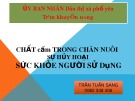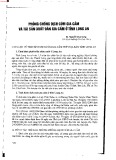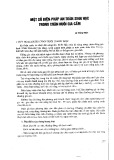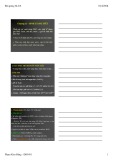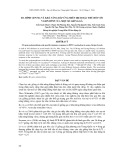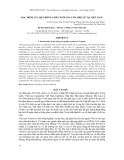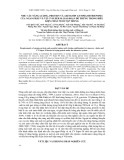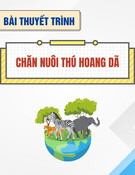
DƯƠNG XUÂN TUYỂN – Hiện trang nhiệt độ ẩm độ và cường độ ánh sáng ...
1
HIỆN TRẠNG NHIỆT ĐỘ, ẨM ĐỘ VÀ CƯ
ỜNG ĐỘ ÁNH SÁNG
CỦA CHUỒNG NUÔI VỊT ĐẺ TẠI TRẠI VỊT GIỐNG VIGOVA
Dương Xuân Tuyển1*, Lê Thanh Hải 1 và Hoàng Văn Tiệu2
1Trung tâm Nghiên cứu và chuyển giao TBKT chăn nuôi , s
ố 85/841 Nguyễn Văn Nghi
Phường 7 - Q. Gò Vấp -
TP. HCM
2Viện Chăn nuôi - Thụy Phương - Từ Liêm - Hà Nội
Tác giả liên hệ : Dương Xuân Tuyển
Tel: (08) 8.942.474 / 0913.774.977; Fax: (08) 8.958.864; Email: dxtuyen@gmail.com
ABSTRACT
Study on air temperature, relative humidity and light intensity in laying duck house
The laying duck house of 600 m2 was open-sided house with metal roof. The litter was rice husk. SM meat-type
duck breeders had free access to the out door ground. 33 electrical bulbs hung in straight lines were used in the
house lit from 18:00h to 22:00h each day. Air temperature (0C) and relative humidity (%) was measured in the
centre of the house at 6:00h, 10:00h, 13:30h, 18:00h and 22:00h in two-day intervals during 12 months of the
year. Light intensity was measured once a week at the same daily time as mentioned above at a central point on
the outdoor ground and 15 different points inside the house. Distance between the electrical bulb to the
measuring machine and the measuring machine to the head of duck was 195 cm and 25 cm respectively. Data
used for the calculation of correlation coefficient of daily egg number/female-air temperature and daily egg
number/female-air relative humidity were from the day of 70% laying rate of ducks to the 38th laying week.
Results of the study showed that for the air temperature in the house there was a great difference among time
points of a day, but it was relatively equable among months in the year. Greater attention should be paid for
rearing ducks in the noontime and early afternoon because it was hottest in the day. There was a large variation
of air relative humidity among months of dry and rainy seasons, but it had no noticeable effects on laying rate of
ducks. For light intensity, because it was open-sided house, there was plenty of light in day-time for laying
ducks. In night-time when using electrical bulbs with the power of 75 w/bulb and 4.125 w/m2 of house ground
the light intensity exceeded the standard of 10 lux advised by Cherry Valley company for SM laying ducks. But
in order to light equally in the house electrical bulbs should be hung in alternate order instead of straight line
hanging as it was used.
Key words: Air temperature, relative humidity, light intensity, laying duck house.
ĐẶT VẤN ĐỀ
Nhiệt độ, ẩm độ và cường độ ánh sáng (AS) là 3 yếu tố ngoại cảnh có ảnh hưởng lớn đến thể
trạng và năng suất vật nuôi cũng như hiệu quả kinh tế. Chúng ảnh hưởng đến nhiều khía cạnh
như mức tiêu thụ thức ăn (TA), nước uống hằng ngày, trạng thái sức khỏe, bệnh tật, tiết hóc-
môn sinh dục (LH, FSH) liên quan đến sinh sản…Do đó, đã có nhiều công trình nghiên cứu
ảnh hưởng của chúng đến năng suất (NS) gia cầm. Theo (Yaha và cs, 2000) nghiên cứu (NC)
ảnh hưởng của nhiệt độ (To) và ẩm độ (Ao) tương đối đến NS của gà đẻ, thấy rằng thay đổi
của nhiệt độ có ảnh hưởng lớn hơn đến NS so với ảnh hưởng của ẩm độ tương đối. (Spinu và
cs, 2003) theo dõi nhiệt độ và ẩm độ tương đối của 2 mùa tại Israel, yếu tố mùa vụ có ảnh
hưởng đến tập tính và NS của gà. Ảnh hưởng của nhiệt độ môi trường đến mức tiêu thụ TĂ,
NS trứng, độ dày vỏ trứng, phát triển lông của gia cầm đã được (AL Saffar và Rose,
2001,2002), (Wylie và cs, 2001) đề cập. Nhiều tác giả đã NC ảnh hưởng của cường độ AS đến
NS sinh sản của gia cầm của (Yeh và Wang, ,1999); Leeson và cs, 2004; Lewis và cs, 2005
a,b). Quy trình nuôi dưỡng vịt giống ông bà SM của hãng Cherry Valley (Anh) đều cho rằng

VI ỆN CHĂN NUÔI - Tạp chí Khoa học Công nghệ Chăn nuôi - Số 13-Tháng 8-2008
2
cường độ chiếu sáng nhân tạo thích hợp tối thiểu là 10 lux. Sử dụng 1 bóng dây tóc 60 w cho
12 m2 chuồng nuôi.
Đề tài được thực hiện tại trại vịt giống VIGOVA, huyện Bến Cát, tỉnh Bình Dương năm 2005
nhằm theo dõi biến động trong ngày và qua các tháng trong năm của 3 yếu tố là nhiệt độ, ẩm
độ tương đối và cường độ AS tự nhiên và nhân tạo, trong chuồng nuôi vịt đẻ SM là hệ thống
chuồng mở tiêu biểu cho kiểu chuồng trại nhiệt đới, cũng như tương quan giữa nhiệt độ, ẩm
độ tương đối/ngày và tỷ lệ đẻ.Từ đó, làm cơ sở cải tiến quy trình nuôi dưỡng phù hợp.
VẬT LIỆU VÀ PHƯƠNG PHÁP NGHIÊN CỨU
Hệ thống chuồng trại và dụng cụ đo lường
Mô tả hệ thống chuồng trại: Mỗi chuồng vịt đẻ có diện tích 600 m2, 12 mét (rộng) x 50 mét
(dài) gồm 12 gian. Khung đà bằng sắt, mái lợp tôn, nền cát, tường 2 đầu chuồng xây kín,
nhưng xung quanh xây thấp 1 mét để thông thoáng. Đây là kiểu chuồng mở thích hợp thời tiết
khí hậu nhiệt đới. Mật độ nuôi 2,0-2,5 con vịt đẻ/m2 cho giống vịt cao sản hướng thịt CV-
Super M. Sân chơi bằng gạch tàu, có trồng cây tạo bóng mát.
Hệ thống đèn chiếu sáng: Sử dụng đèn dây tóc bóng tròn 75w. Giữa 2 gian chuồng là 1 dãy
gồm 3 bóng (Xem sơ đồ 1.). Có tất cả 11 dãy gồm 33 bóng đèn, công suất trung bình (TB)
4,125 w/m2 (quy trình chăn nuôi của hãng Cherry Valley cho vịt ông bà CV Super M là 5
w/m2). Hệ thống đèn được bật sau 18 giờ cho đến 22 giờ.
Thiết bị đo lường: Đo nhiệt độ và ẩm độ tương đối bằng đồng hồ cơ; đo cường độ ánh sáng
(Lux) bằng máy Extech 401025 của Đài Loan.
Phương pháp nghiên cứu
Nhiệt độ và ẩm độ tương đối chuồng nuôi
Thu thập số liệu vào các thời điểm 6h, 10h, 13h30, 18h và 22h trong ngày. Cứ 2 ngày thu thập
số liệu 1 lần, trong suốt 12 tháng/năm. Vị trí đo giữa chuồng. Cường độ ánh sáng: Cứ 7 ngày
đo 1 lần vào lúc 6h, 10h, 13h30, 18h (AS tự nhiên) và 22h (AS nhân tạo), trong suốt 12
tháng/năm. Gồm 16 điểm đo: 1 điểm ngoài sân, 15 điểm trong chuồng (xem sơ đồ 1.). Vị trí
đặt máy đo cách mặt đất khoảng 25 cm (bằng khoảng cách từ mặt đất đến đầu con vịt đẻ) và
cách nguồn sáng là 195 cm. Phương pháp đo theo hướng dẫn của hãng Extech.
Sơ đồ 1. Vị trí đặt máy đo cường độ ánh sáng (trong chuồng từ 1 đến 15)
Tương quan giữa nhiệt độ, ẩm độ tương đối/ngày và tỷ lệ đẻ: Bắt đầu từ lúc vịt đẻ 70% cho
đến tuần đẻ 38 (tỷ lệ đẻ còn trên 60%), NC trên đàn vịt đẻ dòng mái SM.

DƯƠNG XUÂN TUYỂN – Hiện trang nhiệt độ ẩm độ và cường độ ánh sáng ...
3
Xử lý số liệu
Số liệu được xử lý thống kê trên máy tính bằng phần mềm Minitab Ver.12 .
Phân tích ảnh hưởng của các yếu tố bằng General Linear Model (GLM) trong MINITAB.
Đơn vị đo nhiệt độ là độ C (oC); của độ ẩm tương đối là (%) và cường độ ánh sáng là (Lux).
KẾT QỦA VÀ THẢO LUẬN
Biến động của nhiệt độ và ẩm độ tương đối trong ngày và trong năm
Bảng 1. Nhiệt độ, ẩm độ tương đối tại từng thời điểm trong ngày và qua các tháng trong năm
Thời điểm trong ngày
Tháng
Chỉ tiêu Tham số
thống kê 6h 10h 13h30 18h 22h
Bquân
ngày
n 16 16 16 16 16 80
Mean 22,34 29,22 32,03 28,22 25,19 27,40
Nhiệt độ
StDev 1,26 1,17 1,18 1,13 0,93 3,54
n 16 16 16 16 16 80
Mean 83,50 55,94 45,47 66,75 74,81 65,29
1
Ẩm độ
tương
đối StDev 4,18 4,84 9,81 5,25 7,66 15,02
n 14 14 14 14 14 70
Mean 22,82 29,61 32,46 28,75 25,25 27,78
Nhiệt độ
StDev 0,80 0,98 2,47 1,45 0,85 3,69
n 14 14 14 14 14 70
Mean 82,29 52,93 43,64 62,29 77,21 63,67
2
Ẩm độ
tương
đối StDev 4,86 4,48 4,43 5,50 3,22 15,24
n 15 15 15 15 15 75
Mean 23,00 30,07 34,40 29,33 25,9 28,54
Nhiệt độ
StDev 1,96 1,86 1,45 0,82 0,99 4,16
n 15 15 15 15 15 75
Mean 85,07 52,83 41,67 57,67 75,73 62,59
3
Ẩm độ
tương
đối StDev 4,51 5,13 4,39 2,50 2,82 16,30
n 15 15 15 15 15 75
Mean 24,87 31,10 35,70 30,23 27,33 29,85
Nhiệt độ
StDev 0,99 1,80 1,39 0,46 0,59 3,86
n 15 15 15 15 15 75
Mean 85,33 56,93 41,83 60,03 75,47 63,92
4
Ẩm độ
tương
đối StDev 2,82 9,74 5,59 3,56 2,36 16,14
n 16 16 16 16 16 80
Mean 25,19 32,16 35,09 29,16 26,97 29,71
Nhiệt độ
StDev 0,68 1,49 2,82 2,28 1,07 4,00
n 16 16 16 16 16 80
Mean 87,19 55,75 46,69 67,13 79,56 67,26
5
Ẩm độ
tương
đối StDev 2,07 6,81 11,83 9,20 3,46 16,68
n 15 15 15 15 15 75
Mean 24,67 32,32 34,26 27,57 26,17 28,95
Nhiệt độ
StDev 0,70 1,75 3,56 2,48 1,33 4,28
6
n 15 15 15 15 15 75

VI ỆN CHĂN NUÔI - Tạp chí Khoa học Công nghệ Chăn nuôi - Số 13-Tháng 8-2008
4
Thời điểm trong ngày Tháng
Chỉ tiêu Tham số
thống kê 6h 10h 13h30 18h 22h
Bquân
ngày
Mean 87,93 56,07 52,90 74,70 80,93 70,70 Ẩm độ
tương
đối
StDev 1,94 6,03 13,66 8,08 3,26 15,80
n 15 15 15 15 15 75
Mean 24,13 30,06 32,67 26,33 24,77 27,59
Nhiệt độ
StDev 1,00 1,52 3,42 2,06 1,15 3,84
n 15 15 15 15 15 75
Mean 85,27 61,83 57,00 75,33 81,80 72,25
7
Ẩm độ
tương
đối StDev 2,74 8,48 12,04 8,78 4,07 13,57
n 16 16 16 16 16 80
Mean 24,66 31,28 32,53 27,63 26,31 28,48
Nhiệt độ
StDev 0,63 1,48 3,14 1,78 1,12 3,49
n 16 16 16 16 16 80
Mean 87,00 57,75 53,38 70,94 79,94 69,80
8
Ẩm độ
tương
đối StDev 1,97 4,88 10,27 8,15 4,52 14,38
n 15 15 15 15 15 75
Mean 24,57 30,73 31,93 27,63 26,00 28,17
Nhiệt độ
StDev 0,88 1,61 3,01 1,62 1,01 3,30
n 15 15 15 15 15 75
Mean 87,47 58,47 54,80 74,13 81,53 71,28
9
Ẩm độ
tương
đối StDev 3,18 6,12 11,32 7,04 2,85 14,44
n 15 15 15 15 15 75
Mean 24,43 31,83 33,80 27,33 25,70 28,62
Nhiệt độ
StDev 0,53 1,46 1,37 1,37 1,24 3,82
n 15 15 15 15 15 75
Mean 87,80 52,73 47,67 75,13 80,87 68,84
10
Ẩm độ
tương
đối StDev 1,21 4,13 5,35 4,75 2,95 16,39
n 13 13 13 13 13 65
Mean 24,04 30,73 32,00 26,77 25,23 27,75
Nhiệt độ
StDev 0,75 1,67 3,05 1,52 0,75 3,56
n 13 13 13 13 13 65
Mean 86,77 57,31 49,15 75,54 81,77 70,11
11
Ẩm độ
tương
đối StDev 2,49 5,94 6,67 4,75 2,49 15,30
n 15 15 15 15 15 75
Mean 22,37 27,80 29,77 26,23 23,83 26,00
Nhiệt độ
StDev 1,06 2,19 2,60 1,81 1,48 3,26
n 15 15 15 15 15 75
Mean 81,20 58,20 54,13 69,20 77,33 68,01
12
Ẩm độ
tương
đối StDev 6,20 6,07 10,84 8,78 7,91 13,22
n 180 180 180 180 180 900
Mean 23,93 30,58 33,07 27,95 25,74 28,25
SE 0,10 0,15 0,22 0,15 0,10 0,13
Nhiệt độ
StDev 1,39 2,01 2,97 2,01 1,39 3,86
Bình
quân/
năm
n 180 180 180 180 180 900

DƯƠNG XUÂN TUYỂN – Hiện trang nhiệt độ ẩm độ và cường độ ánh sáng ...
5
Thời điểm trong ngày Tháng
Chỉ tiêu Tham số
thống kê 6h 10h 13h30 18h 22h
Bquân
ngày
Mean 85,58 56,41 49,05 69,02 78,88 67,80
SE 0,30 0,49 0,78 0,67 0,37 0,52
Ẩm độ
Tương
đối StDev 3,98 6,58 10,52 8,93 4,96 15,47
Nhiệt độ
Nhiệt độ BQ trong ngày/cả năm là 28,250C, cao nhất tháng 4 (29,850C) và tháng 5 (29,710C).
Đây là các tháng cuối mùa khô. Nhiệt độ thấp nhất tháng 12 (260C) và tháng 1 (27,4oC). Tính
theo từng thời điểm trong ngày, TB cả năm, nhiệt độ cao nhất 13h30 (33,07oC), kế đến là 10h
(30,58oC). Nhiệt độ về đêm (22h) chỉ còn 25,740C). Nhiệt độ thấp nhất lúc 6h sáng (23,9oC).
Như vậy, biến động của nhiệt độ giữa các thời điểm khác nhau trong ngày là lớn, còn so sánh
giữa các tháng/năm thì điều hòa hơn. Theo số liệu khí tượng thủy văn (Tổng cục thống kê,
2004) thì nhiệt độ BQ đo tại Vũng Tàu cao nhất tháng 4 và 5 (29,2-29,3oC) và thấp nhất là
tháng 1, 2, 12 (25,6-26oC). Thời điểm nhiệt độ cao nhất 38,5oC lúc 13h30 và lạnh nhất là 18oC
lúc 6h sáng. Nhiều tác giả đã NC và đưa ra cảnh báo sự ảnh hưởng xấu của nhiệt độ môi
trường cao đến thể trạng và NS của gia cầm. Nhiệt độ cao làm giảm KL trứng, độ dày vỏ
trứng và tăng tỷ lệ dập vỡ trứng gà (Yahav và cs, 2000). Theo (Al Saffar và Rose, 2001), so
với nhiệt độ 21oC, các mức nhiệt độ cao hơn, đặc biệt là trên 25oC làm giảm mạnh NS trứng,
tiêu thụ (TĂ) và tỷ lệ phần trăm của vỏ/khối lượng vỏ trứng.
Bảng 2. Ảnh hưởng của các yếu tố về thời gian đến nhiệt độ và ẩm độ tương đối
Chỉ
tiêu
Nguồn biến Độ tự
do/DF
Tổng bình
phương hiệu
chỉnh
Trung bình
bình phương
hiệu chỉnh
F P
Tháng 11 926,3 84,21 29,59 0,000
Thời điểm trong ngày 4 9630,59 2407,65 845,93 0,000
Tương tác tháng *thờiđiểm 44 390,52 8,88 3,12 0,000
Nhiệt
độ
Sai số ngẫu nhiên 839 2387,92 2,85
Tháng 11 8564,3 778,6 18,87 0,000
Thời điểm trong ngày 4 165528,0 41382,0 1002,94
0,000
Tương tác tháng*thời điểm 44 5811,5 132,1 3,20 0,000
Ẩm
độ
tương
đối Sai số ngẫu nhiên 839 34617,9 41,3
Ẩm độ tương đối
Ẩm độ tương đối BQ ngày cao nhất là 72,25% tháng 7. Tiếp là tháng 9 (71,28%). Đây là các
tháng mùa mưa của các tỉnh phía Nam. Ẩm độ thấp nhất tháng 3 (62,59%, kế là tháng 2
(63,67%) và tháng 4 (63,92%) là tháng mùa khô. Ẩm độ tương đối BQ năm là 67,8%. Tại
từng thời điểm đo trong ngày, cao nhất là 6h sáng (85,58%) và thấp nhất 13h30 chiều
(49,05%). Ẩm độ có biến động lớn, có thời điểm đo đựợc là 91% (6h sáng) và thấp nhất 30%
(13h30). Ẩm độ tại Vũng Tàu cao nhất là 83% vào tháng 8 và thấp nhất 75% vào tháng 1 của
năm 2004 (Tổng cục thống kê, 2004).
(Yahav và cs, 2000) cho biết ẩm độ cao có ảnh hưởng không tốt đến một số chỉ tiêu NS của gà
đẻ như: Khối lượng cơ thể, SL trứng…Theo Spinu và cs, (2003), có sự khác nhau khá lớn về
ẩm độ tương đối giữa các thời điểm trong ngày. Vào mùa hè, dao động từ 42% (14h) đến 68%

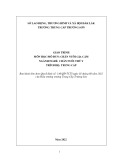
![Tiêu chuẩn ngành 10 TCN 837:2006: Tổng hợp [chuẩn SEO]](https://cdn.tailieu.vn/images/document/thumbnail/2016/20160801/thangnamvoiva10/135x160/741470018472.jpg)
![Tiêu chuẩn ngành 10 TCN 83:2006: [Thông tin chi tiết/Hướng dẫn sử dụng/Cập nhật mới nhất]](https://cdn.tailieu.vn/images/document/thumbnail/2016/20160801/thangnamvoiva10/135x160/2371470017293.jpg)
